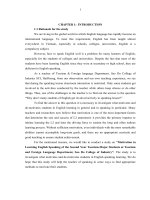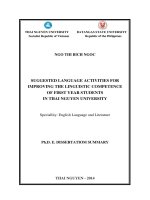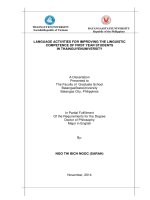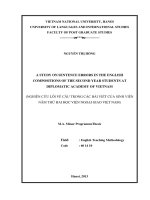Some factors affecting english proficiency of the first year non-english majored students at Hung Vuong University
Bạn đang xem bản rút gọn của tài liệu. Xem và tải ngay bản đầy đủ của tài liệu tại đây (471.64 KB, 10 trang )
<span class='text_page_counter'>(1)</span><div class='page_container' data-page=1>
TRƯỜNG ĐẠI HỌC HÙNG VƯƠNG
Tập 21, Số 4 (2020): 87-96 Vol. 21, No. 4 (2020): 87-96HUNG VUONG UNIVERSITY
<i>Email: Website: www.hvu.edu.vn</i>
<b>SOME FACTORS AFFECTING ENGLISH PROFICIENCY OF THE FIRST YEAR </b>
<b>NON-ENGLISH MAJORED STUDENTS AT HUNG VUONG UNIVERSITY</b>
<b>Dang Luu Ngoc Hoa1<sub>*, Vu Thi Quynh Dung</sub>1<sub>, </sub></b>
<b>Pham Thi Thu Huong1<sub>, Nguyen Thi Minh Loan</sub>2</b>
<i>1<sub>Faculty of Foreign Languages, Hung Vuong University, Phu Tho, Vietnam </sub></i>
<i>2<sub>School of Foreign Languages, Thai Nguyen University, Thai Nguyen, Vietnam</sub></i>
Received: 02 December 2020; Revised: 25 December 2020; Accepted: 28 December 2020
<b>Abstract</b>
T
his article aims to examine the factors that affect the first-year students’ English proficiency at Hung VuongUniversity. 48 non-English majored students participating in the study were asked to answer a questionnaire
with a focus on learning environment, learning motivation, and learning strategies. The results showed that
most students were aware of the importance of learning English, but they did not have a favorable environment
or long-term strategies for learning a foreign language. The possible solutions to help students learn English
effectively at university were also proposed.
<i><b>Keywords: Language proficiency, non-English majored students, English influencing factors.</b></i>
<b>1. Introduction</b>
In the era of international integration today,
language proficiency is one of the important
factors that help students adapt to life and
work in the future. So how to improve the
language or English proficiency of students
in universities and colleges? One of the ways
is to find out students’ perceptions of English
learning, because they are the subject of
the learning process, thereby discovering
what students think about their own English
learning should be taken into consideration.
Once they have understood the factors that
affect students’ English proficiency, teachers
will have supportive solutions to help them
learn English effectively.
</div>
<span class='text_page_counter'>(2)</span><div class='page_container' data-page=2>
environment and proper strategy for learning
English. At the same time, they have never
been motivated to pursue a foreign language
as a favorite subject or for long-term
purposes, but only to pass the exam. That’s
why the researchers identified environment,
strategy and motivation are three important
factors affecting English proficiency of the
freshmen at Hung Vuong university.
So, what is English proficiency?
Researchers has different concepts about
English proficiency, according to the
definition by University of South Queensland
[1], English proficiency is “students’ ability
to use English to make and communicate
meaning verbally and in writing during their
program of study”.
Regarding to academic environment,
teachers who have good knowledge of the
subject and devote enough time to teaching,
are seen as a key factor in fostering positive
learning environments. Teachers are able to
create an effective learning environment in
the classroom, understand the curriculum
and its purpose, make changes in teaching
and learning methods [2]. However, learning
a foreign language can take place inside or
outside of the classroom. Teachers should not
limit the teaching of English in the classroom.
They should see school, family and society
as three mutually supportive aspects. In this
way, they can educate students in a holistic
manner [3]
Another significant factor in learning
a foreign language is learning strategy
which refers to the methods students use to
learn. Researchers have provided specific
examples of language learning strategies,
such as learners may watch TV programs
in English and guess the meaning of new
phrases or predict what will happen [4, 5].
Effective learners also actively associate
new information with existing information
in long-term memory, and they tend to apply
strategies in accordance with their needs and
characteristics of the task [6].
Once students have proper learning
strategy and environment, they need to be
motivated to achieve their goals. Motivation
is defined in different ways, as “an inner
drive, impulse, emotion or desire that moves
one to a particular action” [7]. Motivation
helps learners actively participate and
self-study a second language. On the contrary,
learners who are not motivated will
participate passively and therefore cannot
develop their potential linguistic skills.
Other researchers defined two important
motivation types in language learning are
integrative and instrumental [8]. Integrative
motivation refers to students who wish
to integrate into the target culture. Those
students tend to learn English as they love
this subject and they themselves would like
to widen their knowledge in English. If a
student is instrumentally motivated, his/her
goals are to achieve a certain reward such
as promotion or good grades, or sometimes
pressure from parents.
</div>
<span class='text_page_counter'>(3)</span><div class='page_container' data-page=3>
the influencing factors as well as solutions to
help them in their English learning process.
<b>2. Methods</b>
<i><b>2.1. Research subjects</b></i>
Participants in the study were 48 freshmen
at Hung Vuong University who were not
majored in English. These students had just
taken the National High School Examination
in the academic year 2019-2020, and were
currently studying in different faculties at
HVU. Out of 48 students, 30 were female and
18 were male and all took the KET entrance
English proficiency test in 2019.
According to the survey result, the
majority of the students (76%) lived in
rural areas in the mountainous areas of the
Northern Vietnam. Therefore, their English
proficiency was generally low (based on
the result in the national high school exam).
Although having learnt English for a long
time (7-10 years so far), they only focused
on English grammar for the final tests and
had no practice in speaking and listening
skills. As a result, they all got low marks in
the proficiency test (KET) and shared the
similar mark range of 10-15/25 in the KET
listening and speaking test.
<i><b>2.2. Data collection tools</b></i>
To find out the factors affecting English
proficiency of non-English majored students,
the study used questionnaires designed based
on the synthesis and analysis of previous
studies.
The survey questionnaire consisted of 18
questions, divided into two parts; in which
part I explores background information of
participants (such as age, gender, origin, input
English level, reasons for learning English,
etc.). Part II includes 12 questions related to
factors affecting English learning, focusing
on the learning environment, motivation and
learning strategies.
The questionnaire was designed in the
google form with a list of multiple-choice
questions and delivered to the participants
at the beginning of the second semester of
the academic year 2019-2020, just before
they started joining the English proficiency
course. The participants answered the
questionnaire on their mobile phone, and
after 30 minutes the researchers got the
results in the excel form which showed the
percentages of choices for each question.
The collected data then was analyzed
by using quantitative methods. Firstly,
descriptive statistics was utilized to gain the
percentage of choices; then the researchers
used the inferential statistics to make
judgments and reached possible conclusions.
<b>3. Results and discussion</b>
<i><b>3.1. Results about the factors affecting </b></i>
<i><b>students’ English proficiency </b></i>
After the participants answered the survey,
the results were synthesized and analyzed on
factors that affect English learning as well as
language proficiency.
<i>3.1.1. Learning motivation</i>
</div>
<span class='text_page_counter'>(4)</span><div class='page_container' data-page=4>
<b>Table 1. Motivation to learn English by non-majored students</b>
<b>Reasons</b> <b>Number of choices</b> <b>Percentage (%)</b>
English is my favorite subject 8 16,6%
Expanding understanding 5 10,4%
Achieving high scores in exams 30 62,4%
English is a compulsory subject 37 77%
Finding opportunities to study abroad 0 0
English is essential for a future job 28 57,8%
Most students believed that learning
English was very important for their
future, as responded in the first question
of the questionnaire. However, most of
the respondents reported that they studied
English as it was a required subject in the
university curriculum (77%), followed by
a high score on the module exam (62,4%).
More than half of the students stated that
they hoped that good English skills would
help them find a job after graduation as well
as useful for their future work (57,8%). Only
8 people (16,6%) studied English because it
was their favorite subject. The least choice
was to expand knowledge or culture with
10,4% of the total. Noticeably, no one chose
to study English with the aim to study abroad.
These students did not have strong desire
to learn English as the first-year students
did not pay much attention to English and
it was likely that they would not choose to
study English in four years of university if
it was not a compulsory subject. Freshmen
mainly identified the motivation to study in
short-term goals such as getting scores but
not a long-term orientation as English was
essential for their future work or studying
abroad, etc. In this case, the majority of
the students had instrumental motivation
in learning English. However, there were
still a few students considering English as
their favorite subject who got high scores in
English entrance exams. Obviously, when
learning English is no longer a compulsion
but a love and a strengthened motivation, the
learning quality of students will surely be
improved.
<i>3.1.2. Learning environment</i>
With regards to the student’s learning
environment inside and outside the classroom,
the question related to learning aids at home
has revealed a lot of interesting information
(Table 2).
<b>Table 2. English learning aids at home</b>
<b>Learning aids</b> <b>Number of choices</b> <b>Percentage (%)</b>
Dictionary 45 93,6%
Internet connection 47 97,7%
References 35 72,8%
</div>
<span class='text_page_counter'>(5)</span><div class='page_container' data-page=5>
The data showed that most students
had a variety of foreign language learning
facilities at home, such as dictionaries (either
paper or electronic dictionaries), and had the
internet connection, but another question
was whether they used the media to support
their English learning or not. In addition,
three quarters of the respondents said they
had reference books and materials to support
foreign language learning. Today, there are
a great number of applications and software
to help students integrate skills and learn by
themselves; however, less than a quarter of
participants (20.8%) used this medium. It
can be seen that once students consciously
use these softwares, they have defined the
goal of learning foreign languages as well as
have a sense of long-term learning.
When it came to the learning environment
in the classroom, the majority of students
agreed that learning English required
interaction between learners in groups (79%).
Additionally, some respondents said that
interaction between teachers and students
was very important because it would help
improve students’ foreign language skills;
but this was just a few choices, accounting
for only 12,5%, maybe they were still shy
or afraid of discussing face to face with a
teacher (Table 3).
<b>Table 3. English learning environment at school</b>
<b>Type of interaction</b> <b>Number of choices</b> <b>Percentage (%)</b>
Practice with the whole class 15 31,2%
Practice in pairs or small groups 38 79%
Independent interaction with a teacher 6 12,5%
Another equally important aspect was
to find out information about the time they
spent on the subject outside of the classroom
to broaden and deepen the contents of
the course. Out-of-class results were also
remarkable (Table 4).
<b>Table 4. The environment for learning English outside the classroom</b>
<b>Activities </b> <b>Number of choices</b> <b>Percentage (%)</b>
Watching television, reading on the Internet or listening in English 25 52%
Practice communicating with native speakers 7 14,5%
Joining an English club 22 45,8%
Taking extra classes in after-school classes 15 31,2%
Using software applications to learn English 15 31,2%
It could be seen that many students were
aware of the importance of English in modern
life, thus giving themselves tasks such as
watching television, reading on the internet
or listening in English (52%) to practice and
</div>
<span class='text_page_counter'>(6)</span><div class='page_container' data-page=6>
materials to support English learners and to
meet the needs of learning English outside
of their regular course. Many active students
have joined English club, both to study and to
make friend relation, to entertain them after
stressful lessons. The least commonly used
self-study method was communication with
native speakers which was selected by only 7
people. Perhaps students were still afraid, not
confident with their English ability, so they
did not dare to connect with native speakers.
<i>3.1.3. Learning strategy</i>
One of the important factors in learning a
foreign language is that learners need to have
the right learning strategies. The results of the
participant survey revealed many interesting
information.
<b>Table 5. Strategies for learning English</b>
<b>Strategies </b> <b>Number of choices</b> <b>Percentage (%)</b>
Practice communication skills in English 30 62,4%
Relating existing knowledge to new concepts / knowledge 23 46,9%
Using different mnemonic techniques 36 74,8%
Asking for clarifying a problem 28 58,2%
Not afraid of making mistakes in the learning process 10 20,8%
Confident speaking English in front of the class 13 27,1%
Seeking information from different sources 18 37,5%
Participants in the study have used various
strategies in learning foreign languages,
of which the most popular ones were
applying memorization techniques (74,8%),
English communication practice (62,4%)
and clarifying what was not understood
(58,2%). This showed that the majority of
the students had correct learning methods
once they had determined motivation to
learn English. However, only a small number
of students (10 out of 48 participants) felt
confident showing off their abilities in front
of the classmates. This has revealed that
students needed to have a more practical
communication environment in order not to
feel shy and embarrassed to communicate in
English.
<i><b>3.2. Suggested solutions to enhance </b></i>
<i><b>students’ English proficiency</b></i>
<i>3.2.1. Utilizing the materials to raise </i>
<i>motivation in learning English</i>
When students are having a good time,
they will be more engaged in learning. Their
motivation will come from them rather than
from teachers. Thus, teachers just have to
find the best ways to help their students have
a good time while they learn.
</div>
<span class='text_page_counter'>(7)</span><div class='page_container' data-page=7>
from their learning and at the same time make
language use practical. Currently, Complete
Key for Schools is the official textbook in the
English proficiency course at HVU. With the
first topic about Introduction and Daily life,
teachers may ask students to record videos
introducing themselves and what they do
one day from the morning they wake up
until they go to bed in the evening. Then, the
classmates will choose Like to vote for the
video they enjoy. The video with the most
Likes wins the race.
Another example is the topic Food and
drink which students work in groups and
record videos describing how to prepare
their favorite food or going to their favorite
restaurant. Also, the teacher can ask students
to write a piece of memory related to food,
then share it on the facebook group. Another
way is to play a quiz, in which students take a
video of the ingredients to make a dish and ask
the others to guess what dish. For each topic,
teachers need to have specific requirements,
associated with real life and suitable with
students’ level so that they can use English.
And after each voting test, teachers can add
up the scores for the winning students to get
motivation for the next time.
Another way to involve students in
learning is integrating “pop culture” into
class. That means using different types of
entertainment in the lesson, such as using
songs or movies for listening skill, adapting
magazines in reading activities or learning
new vocabulary, etc. It is time teachers got
out of the textbook and involved in what
their students do for entertainment, such
as the music they like, the types of movies
they watch and what they enjoy on TV, etc.
Then they include these resources whenever
possible to guarantee that they’re motivated
and engaged with the activity.
In addition, students tend to be excited
about playing games. So why don’t teachers
use games for students to review vocabulary
or grammatical structures? Popular online
games like Quizizz, Kahoot or Scrabble really
attracts students. Those games absolutely get
students out of boredom when they learn new
words or grammar as in traditional ways.
<i>3.2.2. Creating favorable learning </i>
<i>environment</i>
</div>
<span class='text_page_counter'>(8)</span><div class='page_container' data-page=8>
develop good reading habits and enhancing
their interest in extensive reading.
Language proficiency is best raised
through active and frequent use. It is
important to provide students with maximum
English exposure as well as meaningful and
purposeful activities through which they can
learn and apply the language. One way to
achieve it is setting up an English -speaking
community. This model can be built into
three levels. The first one is the pilot model
with the participation of one faculty in
which students exchange and study on issues
related to their majors. In this pilot model,
the Teacher Union will be in charge of the
meeting and organize discussion activities.
The next level is the English club for
English-majored and non-majored students
which they themselves are responsible for all
the contents and discussion. The third level
is sharing learning experiences via Microsoft
Teams. In this level, all the students who are
interested in, can join the meeting. The online
sharing session on Microsoft Teams will be
hosted by one English teacher, one group of
English-majored students and representatives
of other faculties. They will discuss on
a number of topics such as how to learn
Listening, Speaking, Reading and Writing
skills or content that is tailored to students’
needs. The English-speaking community
is aimed to create a useful playground for
students to exchange and learn from each
other, and at the same time create an English
environment for all teachers and students at
school.
<i>3.2.3. Identifying proper learning </i>
<i>strategies</i>
It is essential to get advice from
experienced and qualified educators who
will provide instructions and suggestions
to define learning strategies for first year
students. They will create excitement in
learning English for students, thereby
stimulating and encouraging them to learn
and from achieve good results.
A large number of students have the habit
of waiting until the night before a test to study
for it; but they cannot afford a great amount of
information over time. Thus, teachers should
create a studying calendar to plan out how
they will review chunks of content, and by
carving out small chunks of class time every
day for review. Teachers may ask students
to practice peer-review and communication
in English as much as possible, as they tend
to learn more from mistakes and from peers
than on their own.
</div>
<span class='text_page_counter'>(9)</span><div class='page_container' data-page=9>
information is stored so that it’s easier for
them to get to later on.
These strategies don’t necessarily work
in isolation but in combination. Students can
space out their review practice, and at the
same time try to recall concrete examples or
sketch out a concept. When doing retrieval
practice, they can interleave between
different concepts.
<b>4. Conclusions</b>
This article has presented a part of the
research result on the factors affecting the
proficiency of first-year non-English majored
students at Hung Vuong University. The
survey has found out that the students have
identified the English language motivation,
in which the instrumental motivation
predominates. The information obtained can
be used as reference material for program
framework designers, curriculum developers,
especially direct instructors, to help them
review and refine items in training objectives,
time frames, teaching contents and teaching
methods to suit the target learners.
However, the study only investigated
factors affecting students’ English
proficiency from the students’self-awareness
and assessment of their own foreign
language learning, but partly revealed useful
information for teaching English for
non-majored students in the undergraduate years.
With this result, the study has proposed
suggestions for those factors to help enhance
English learning of non-majored students,
with the priority of building
English-speaking community for all the students to
improve communication skills.
<b>References</b>
[1] University of Southern Queensland (2020).
Assessed September 22, 2020, from <https://
usqstudy.custhelp.com/app/answers/detail/a_
id/5007/~/what-is-english-proficiency%3F>.
[2] Kiatkheeree P. (2018). Learning Environment
for Second Language Acquisition: Through
the Eyes of English Teachers in Thailand.
International Journal of Information and
Education Technology, 8 (5), 391-395.
[3] Xiao-li J. & Hui L. (2011). Research on
influence of environments on students’ English
learning in rural schools. Fourth International
Symposium on Knowledge Acquisition and
Modeling, Sanya, 2011, 593-595.
[4] Oxford R. & Nyikos M. (1989). Variables
affecting choice of language learning strategies
by university students. Modern Language
Journal, 73(3), 291-300.
[5] Shi H. (2017). Learning Strategies and
Classification in Education. Institute for
Learning Styles Journal, 1, 24 - 36
[6] Green J. M. & Oxford R. (1995). A closer look
at learning strategies, L2 proficiency, and gender.
TESOL Quarterly, 29(2), 261-297.
[7] Brown D. (1987). Principles of English
Language Learning and Teaching. Second
edition. NewJersey: Prentice Hall.
[8] Gardner R. C. & Lambert W. E. (1972). Attitudes
and motivation in second language learning.
Rowley, MA: Newbury House.
[9] Meisani D. R., Hamied F. A., Musthafa B.
& Purnawarman P. (2020) Factors affecting
Indonesian young learners’ English proficiency
level. TEFLIN Journal, 31(2), 204-229.
[10] Ghazvini S. D. & Khajehpour M. (2011).
Attitudes and Motivation in learning English
as Second Language in high school students.
Procedia Social and Behavioral Sciences, 15,
1209-1213.
</div>
<span class='text_page_counter'>(10)</span><div class='page_container' data-page=10>
<b>MỘT SỐ YẾU TỐ ẢNH HƯỞNG ĐẾN TRÌNH ĐỘ TIẾNG ANH CỦA SINH VIÊN KHƠNG </b>
<b>CHUN NĂM THỨ NHẤT TẠI TRƯỜNG ĐẠI HỌC HÙNG VƯƠNG</b>
<b>Đặng Lưu Ngọc Hoa1<sub>*, Vũ Thị Quỳnh Dung</sub>1<sub>, </sub></b>
<b>Phạm Thị Thu Hương1<sub>, Nguyễn Thị Minh Loan</sub>2</b>
<i>1<sub>Khoa Ngoại ngữ, Trường Đại học Hùng Vương, Phú Thọ </sub></i>
<i>2<sub>Trường Ngoại ngữ, Đại học Thái Ngun, Thái Ngun</sub></i>
<b>Tóm tắt</b>
B
ài viết này nhằm mục đích khảo sát một số yếu tố ảnh hưởng đến trình độ tiếng Anh của sinh viên khôngchuyên năm thứ nhất tại Trường Đại học Hùng Vương. 48 sinh viên không chuyên tham gia nghiên cứu,
được yêu cầu trả lời một bảng khảo sát, trong đó tập trung vào các yếu tố như môi trường, động cơ và chiến lược
học tập. Kết quả cho thấy hầu hết sinh viên đều nhận thức được tầm quan trọng của tiếng Anh, nhưng chưa có
mơi trường thuận lợi hoặc chiến lược dài hạn để học ngoại ngữ. Nghiên cứu cũng đề xuất một số giải pháp để
giúp sinh viên học tiếng Anh hiệu quả trong những năm học sắp tới ở trường đại học.
</div>
<!--links-->
How group work is used in speaking lesson of the first year major students of english at viet nam university of commerce
- 42
- 1
- 4








